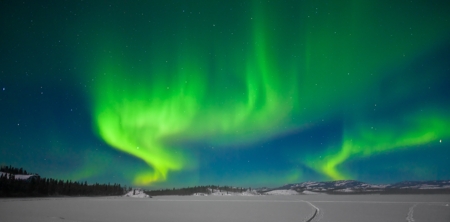Did you know?
Northern lights are known as Aurora borealis in the north and Aurora australis in the south.
What can be said about these beautiful, beautiful dancing lights that brighten up the polar skies? Breathtaking? Yes. Mind-numbingly awesome? Sure. The truth is, that no words can match up to the magic that is nature, and this natural phenomenon is simply an example of the same.
Northern lights, or auroras as they are also known as, are the result of a collision between the coronal mass ejection (CME) with the Earth’s magnetic field.
Quite the anti-climatic explanation for something so spectacular, isn’t it? I agree wholeheartedly. So for now, take a look at these visions and be amazed. The cold, hard facts follow later.
Origins of Northern Lights

The origins of this spectacular light show lies, surprisingly, on the Sun and not the Earth. The temperature above the Sun’s surface is phenomenally high. These temperatures that reach millions of degrees Celsius are conducive for collisions between gas molecules. These collisions give rise to electrons and protons being expelled, escaping from the Sun’s atmosphere. These charged particles are carried towards the Earth through solar winds.
In normal circumstances, the Earth’s magnetic field repels these particles. However, since our planet’s magnetic field is weaker at the poles, the charged particles enter the atmosphere and collide with nitrogen and oxygen atoms, creating brilliant, (mostly) green-hued lights that seem to dance in the skies.
FAQs about Northern Lights

What lends color to these lights and causes different patterns?
The types of ions and the collision predominantly determines the appearance of auroras. Displays have been mainly observed in the following patterns –
Rippling lights
Pulsating globs
Traveling pulses
Steady glows
The color of the auroras are also affected by altitude, with bright green being the most common between 60-150 miles. Deep red auroras are observed more than 150 miles upward.
Are they only visible in the polar regions?
If clarity and frequency is what you want, then the polar regions (Alaska, Canada, Greenland, and Scandinavia) are your best bet, owing to the magnetic field of the Earth. This said, auroras have also been (rarely) sighted closer to the equator around Cuba and Mexico. In regions closer to the equator, you can look towards the northern horizon if you are in the northern hemisphere, and the southern horizon if you are in the southern hemisphere.
Do they only occur at night?
No. Auroral activity can take place all day, all year round. It is just that their visibility is clear in the dark night sky, late evenings, or during dawn.
Can auroras be damaging?
Certainly they can. Despite their apparent beauty, auroras are a result of particles colliding with the Earth’s magnetic field, and they do interfere with our space satellites and even power grids at times.
Why call them northern lights if they have been observed in both hemispheres?
Auroral activity is visible in the northern hemisphere where there is human presence. Southern auroras, on the other hand, are mainly visible over the Antarctic circle and the southern part of the Indian Ocean. This explains why they are informally referred to as ‘northern lights’.
Interestingly, scientists have observed that auroral activity takes place simultaneously at the poles in most cases, and the displays are often found to be mirrored when it comes to the colors and patterns.
Legends and Facts about the Northern Lights

● The earliest mention of northern lights takes us back to 568/567 BC, where references made by Babylonian astronomers were found on a clay tablet.
● A few North American Inuit call the aurora aqsarniit or football players, and believe that the spirits of the dead are playing football with the head of a walrus.
● Kristian Birkeland was the Norwegian scientist who came up with the theory that auroras are triggered by electrons from sunspots.
So the next time you spot these brilliant green lights flashing in the night sky, think of how spectacular Mother Nature is, and how lucky you are to witness her complete glory.











RSS